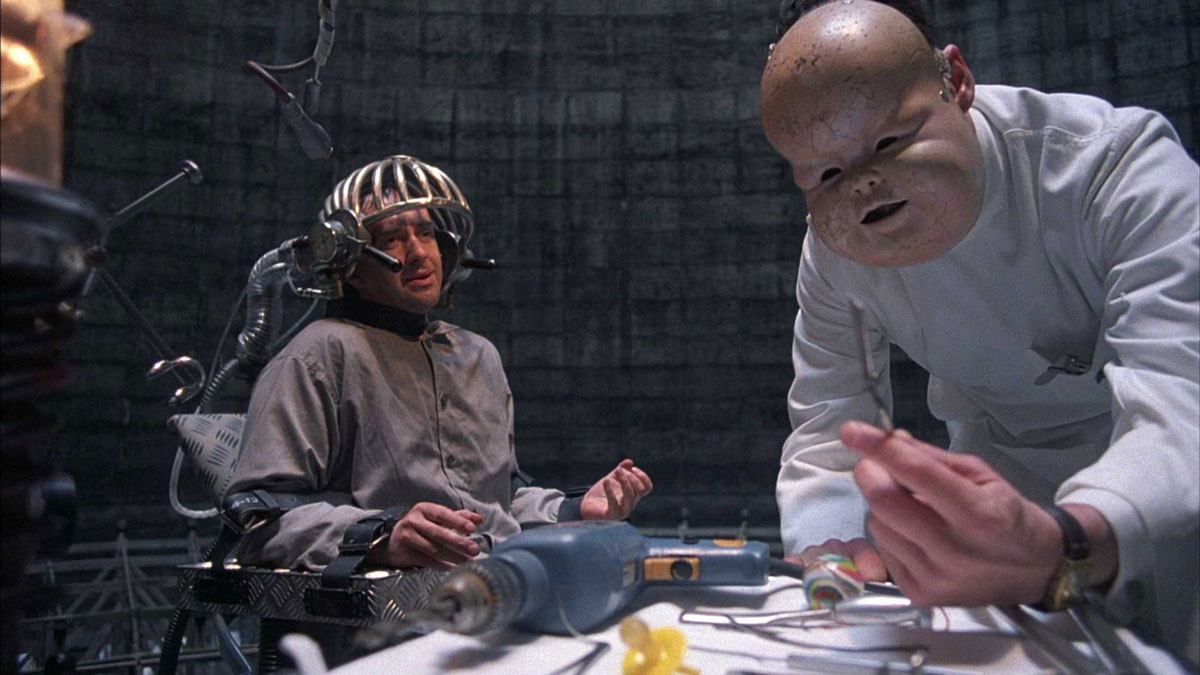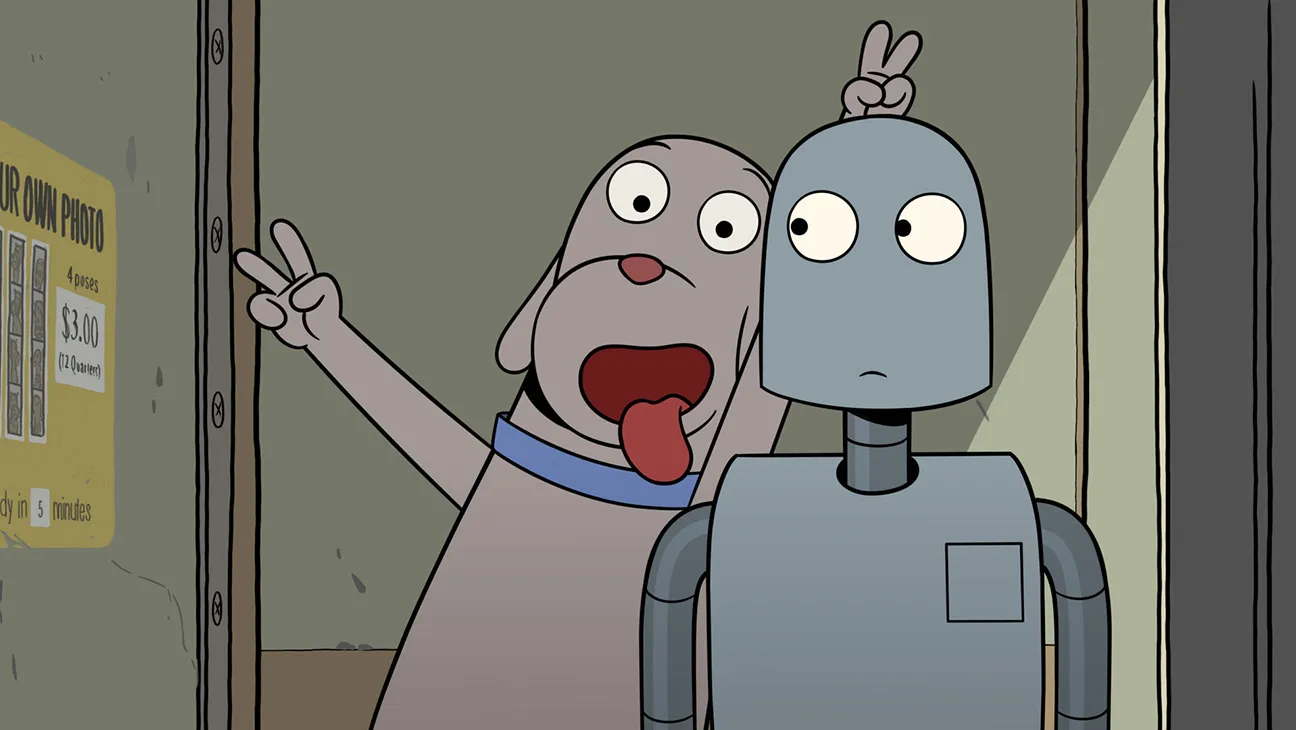by Pauline Kael
The title of Terry Gilliam’s Brazil is used nostalgically in a semi-jokey, ironic way. It refers to the 1939 pop song, sung here by Geoff Muldaur, about the romance of a Brazil “where hearts were entertained in June.” The lyrics end with “Return, I will, To old Brazil.” Heard as a refrain in the background of the movie, the music is meant to evoke the pop escapism of the past. Old Brazil is what you want life to be, and what can only be dreamed about in the squalor and sporadic terrorist violence of an Anglo-American police state “somewhere in the twentieth century”—which means the next fifteen years. Gilliam’s vision comes across as a stoned, slapstick 1984, but it’s not a political cautionary tale, like Orwell’s novel—it’s a melancholy, joke-ridden view of the horribleness of where we are now and the worse horribleness of where we’re heading. It’s an anarchistic attack on all present and future states—an attack on reality itself. And it dissolves the boundaries between fantasy and reality.
An American, born in 1940, who moved to London in the late sixties, Gilliam—and five Englishmen—formed the troupe Monty Python’s Firing Circus, and he first became known for the animated segments he did to fill the gaps in the group’s TV shows. When the group started making movies, he got the chance, in 1974, to co-direct Monty Python and the Holy Grail, and then, in 1977, he directed Jabberwocky, he wanted to make Brazil next but couldn’t get it financed, and it wasn’t until after he’d made the hit film Time Bandits, in 1981, that he got the go-ahead. The movie that he mulled over for years is clearly the work of an image- maker. Gilliam says he’s never read the Orwell book, and that isn’t hard to believe, because Brazil is like the impression you might get of 1984, if you’d just heard about it over the years and it had seeped into your visual imagination.
The characters that Gilliam devised (with his co-screenwriters, Tom Stoppard and Charles McKeown) have something of the comic-strip quality of Godard’s characters in Alphaville, but Godard’s dehumanized metropolis was made up of the sleekest parts of Paris; Gilliam’s dehumanized metropolis is made up of the most medieval-looking structures in and around London, with a few picked up in other parts of England and in Marne-la-Vallee, France, and some designed and built. Visually, Brazil is an original, bravura piece of moviemaking; I assume that it was story- boarded, because the shots keep taking us from high up in towers (which have a perverse grandeur) to way down at street level and up again. The buildings are cold and dour—oppressive stone structures with ramshackle interiors. Inside, they look as if they had been blitzed in the Second World War and never repaired, and the offices and apartments are so high-ceilinged and cavernous that every room seems to be an atrium. The picture has a weirdly ingenious vertical quality: the camera always seems to be moving up and down, rarely across, and this seems like a violation of nature. You get the feeling that people live and work squashed at the bottom of hollow towers, and that everything has been grayed out; the bureaucrats wear suits that are as alike as prison uniforms, and the wide- brimmed fedoras worn straight across their heads are as gray and drab as stone. The women’s freakish clothes, like the furnishings and the ancient TV sets and assorted gadgetry, suggest that nothing has been made or manufactured since the forties. It’s a thrift-shop world of the future.
The central character, Sam Lowry (Jonathan Pryce), is a lowly functionary, a drone, but a dreamer—a Winston Smith-Waiter Mitty. He’s a clerk in the Ministry of Information (MOI) who lives in his fantasies of himself as a knight in silver armor with great, Icarus-like feather wings. Soaring way up high amongst the clouds, he encounters a beautiful blond maiden. The story line is very simple. Sam glimpses the girl of his dream flights when he goes to deliver a check—a “refund”—to a woman whose husband has been “deleted” by bureaucratic error. A bug that was swatted fell into a computer, causing the name Tuttle to be changed to Buttle. And so the state’s Security Forces—i.e., official murderers—killed innocent Buttle, and the freedom fighter Tuttle is still at large. On a realistic level, what happens to Sam is simply that in pursuit of his dream blonde, Jill (Kim Greist), he forgets his usual caution and runs afoul of the state apparatus. There’s also a superrealistic inevitability about this—a fatalism that is tied to fantasy.
If you don’t respond to Sam Lowry’s plight, the picture has no core, but it’s hard to worry about whether somebody will get killed if he doesn’t seem alive to start with. Jonathan Pryce’s Sam is pale and dead-eyed; he looks like a taller version of the young Alec Guinness, but Guinness’s anonymous men let you in on their furtive sparks of nonconformity, and they had some charm. Pryce plays Sam too straight and too wistfully. It’s a real crapehanger’s performance. The marginal characters—especially Katherine Helmond as Sam’s nut-brain mother and Robert De Niro as Tuttle—are far more entertaining. (I hate to think what the movie would be like without them.) Helmond, the American actress who appeared as Mrs. Ogre in Time Bandits, is the rich, powerful widow of a government minister here, and she delivers an elegant, broad caricature of a woman obsessed with plastic surgery, who keeps looking younger and younger. It’s not a big role, but she gets to wear one awe-inspiring dingbat ensemble: a form-fitting leopard jacket with a matching leopard shoe—an outsize one—worn upside down as a hat. De Niro’s role is even smaller—no more than a cameo—but, all revved up and chomping on a cigar, he’s a prankster-daredevil, a comic-strip hero, high-spirited and the life of the party. He even has a healthy color. Tuttle repairs heating systems illicitly (he doesn’t have a license), and when he’s in danger of being caught he slides down a rope as if he were jet-propelled, dropping from the top of an astoundingly tall skyscraper to street level in the blink of an eye. (Tuttle must be the first kinetic Underground Man in the movies.)
Brazil is more antic than comic. It’s full of jokes—some of them very clever—but most of them don’t quite make you laugh. I’m not sure Gilliam wants you to. His intention seems to be to create a new movie genre of nightmare comedy in which the comedy is just an aspect of the nightmarishness. He presents a retro-futurist fantasy (like A Clockwork Orange or Blade Runner) and keeps it perking by cartoon techniques and black humor. The jokes may be something he does compulsively, because that’s how he works—without worrying about whether they’re set up to get a laugh. He uses pop-surreal effects the same way: the heating ducts in Sam’s apartment are like huge intestines stuffed in the walls; when they’re pulled out, they fill the place. But Gilliam never prepares the instant when these gross tubes and cords will invade your consciousness and make you break up. And that’s even more true of the enormous Rube Goldberg-like truck that Jill drives—a mass of cylindrical shapes that you can’t imagine the purpose of. I waited for the joke, expecting Sam to discover what the truck was for, or to ask about it and be rebuffed, but it just goes clanging along. The chase sequence, with Jill and Sam in this monster truck and the authorities in pursuit, is, 1 think, a crucial mistake. It’s pointless: you know that it wouldn’t be necessary if Sam just asked Jill a simple question and she gave him a straight answer. Instead, they go smashing through barricades, getting themselves into more and more trouble. Any developing interest in them collapses, and you begin to think the picture is too long. (It’s two hours and eleven minutes, Gilliam having cut it a little in order to appease Universal.)
It’s fascinating at Brazil not having a clue to what’s coming next, but the things that do show up run together and blur in your mind, because the episodes lack dramatic definition, just as the gags do. Gilliam’s gags don’t have that wonderful zing you experience when the timing itself is a thing of beauty. Asked by Owen Gleiberman, of the Boston Phoenix, if his imagination was always working, Gilliam said, “Yeah, and I don’t try to control it. I do everything in my power to keep things from falling into neat little slots.” Does that mean that his timing has to be lousy? Maybe it does. Maybe it means that his work has to be both torpid and frantic. (Gilliam distrusts the conscious mind as if it would destroy his creativity—though it’s probably the only means of bringing his creativity to fulfillment.)
Brazil is the kind of ornery, intellectually fuzzy labor of love that is bound to strike some people as just about “the worst thing I’ve ever seen,” and perhaps it will affect others as a picture they want for their VCRs, so they can look at it over and over. What Gilliam presents is a vision of the future as the decayed past, and this vision is an organic thing on the screen—which is a considerable accomplishment. I was held by the vertical, anti-human look of things and the sometimes mysteriously eccentric images. When Sam is transferred to Information Retrieval—a place with corridors that go off to infinity—he is shown to a tiny, cell-like office with a half a desk; the other half is on the other side of the wall, where another clerk tries to pull it his way. Sam has to hold on to his half and put all his weight on it to keep it from disappearing through the wall. (It’s a neat, Kafka-esque variation on a very old gag.) A torture chamber at the bottom of an empty, vast domed structure suggests a twenties Expressionist set for a trial, or perhaps a giant amphitheatre for surgeons to display their art. (This movie certainly takes the romance out of high ceilings.) The hugeness of the space in the amphitheatre plays off our awareness that Sam is strapped down and can’t move, but the space also represents his unbounded imagination. One of the “surgeons” (Michael Palin) wears a mask that looks like the face of an evil Oriental doll-child. It’s in hyperbolic images like these that Gilliam’s not letting things fall into “neat little slots” seems the right—possibly the only— way for him to work. Yet I must admit to a feeling of relief when the film was over. What Gilliam appears to be saying is that reality is so intrinsically awful that fantasy will always be needed. But fantasy itself, in Gilliam’s hands, seems something you want to escape from. This image- maker leaves you with nothing but images; they’re like shards or scraps. Brazil makes you feel that no rational understanding of the world is possible—that all we have is what T. S. Eliot called “a heap of broken images.”
The New Yorker, February 10, 1986





